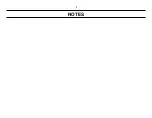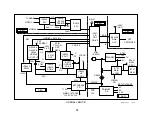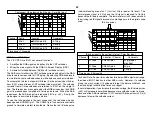
15
Field 1
Field 2
"6i" Interlaced Picture consisting of
alternating lines from fields 1 & 2
SD to HD Conversion Concept
This TV has features designed to bridge the gap between the current
analog sets and newer higher resolution digital TV sets. The KV32XBR400
TV is a high resolution set capable of receiving the current standard defi-
nition (SD) NTSC signal. The NTSC standard resolution of 480i lines is
upgraded to a 960i (interlaced) or 480p (progressive) line picture, to be
compatible with this TV. The user selects interlaced scan if there is mo-
tion in the picture or progressive scan if there is a still picture signal in
order to stop interlace flicker. A higher resolution (480p or 1080i) signal
that does not need to be upgraded can be input to video 5 or 6 for ad-
vanced placement in the video chain.
Interlaced or Progressive Scan
Most technical people do not know how many horizontal lines are present
on the screen in a single scan from the top of the screen to the bottom.
The confusion about the number of lines shown at one time relates to the
different interlace/progressive scan modes.
In the progressive scan mode the entire picture is presented in one scan
of the picture tube (left to right, top to bottom). In an interlaced scan the
entire picture consists of two fields so the picture is presented in
two
scans of the picture tube. The second field is displaced from the first so
the lines fit in-between each other making the completed picture:
The resolution of the TV picture is measured in horizontal lines of a com-
plete picture followed by the letter for the type of scan (i or p). For ex-
ample, the NTSC signal contains 525 horizontal lines. The number of
viewable lines is reduced to 480 because of the time required for V & H
retrace, creating a blanking area above and below the picture. Therefore
the standard resolution NTSC signal displays a 480
i
picture. 480 is the
number of lines in the total picture. The i suffix identifies an interlaced
picture. Since the picture is interlaced, there is only half the number of
lines presented in a single scan. In this case, there are 240 lines dis-
played in a single scan. This is equivalent to a 240p picture that displays
240 lines in a single scan (480i is the same as 240p).
Similarly a 480p picture is like a 960i picture because both these pictures
present 480 horizontal lines per scan. This is important to understand as
the standard resolution NTSC picture is changed to a higher resolution in
the “DRC” video processing stage of this TV.
Standard Definition Video Input
The Tuner and Video 1-4 inputs accept only the NTSC 480i-line standard
definition signal identified by the 15.75kHz horizontal frequency. The 480i
input signal is interlaced (
i
), consisting of two 240-line fields presented/
scanned one at a time that total the 480 lines. Therefore a 480i NTSC
picture normally displays 240 lines each time the picture is scanned. The
NTSC signal passes through the DRC and MID circuits.
DRC Circuit
In this model KV32XBR400 high resolution TV, a single scan must con-
tain 540 lines, more than double of a NTSC signal. The DRC circuit al-
most bridges the gap between the 240 line input signal and the 540 line
TV requirement. The DRC circuit doubles the number of horizontal lines
by analyzing the pixel data to construct new lines. Therefore the DRC
circuit brings the total line count from 240 to 480. The DRC circuit also
doubles the horizontal frequency to 31.5kHz to support these lines.
In a single scan
=
12i Interlaced scan
picture is 6 lines per field
6p Progressive
scan picture
1
2
3
4
5
6
Содержание KV-32XBR400
Страница 1: ......
Страница 5: ...1 NOTES ...
Страница 12: ...8 NOTES ...
Страница 14: ...10 NOTES ...
Страница 83: ...APPENDIX ...
















































